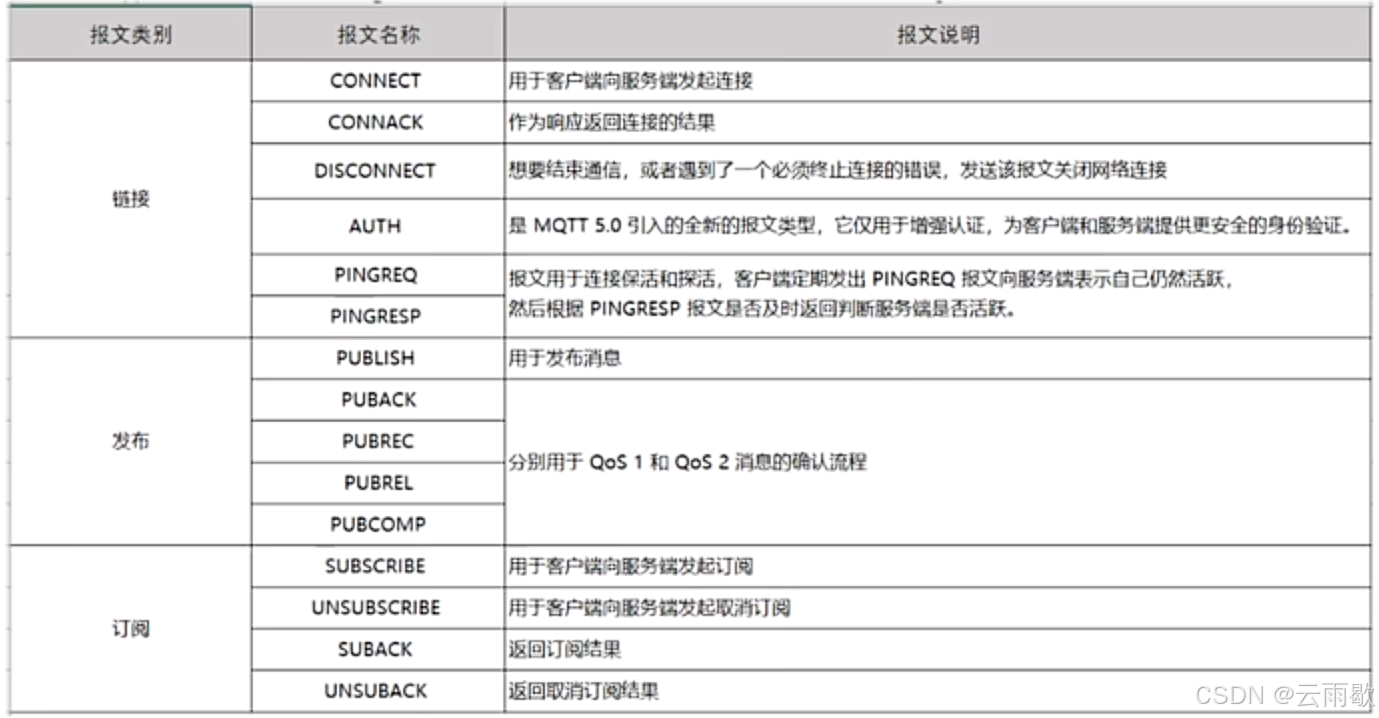Qt学习笔记(三)网络编程
系列文章目录
Qt开发笔记(一)Qt的基础知识及环境编译(泰山派)
Qt学习笔记(二)Qt 信号与槽
Qt学习笔记(三)网络编程
前言
之前我们在Linux应用层的学习时提到了网络编程,本节是进行Qt下TCP / IP 客户端的编写。
一、Qt网络模块
Qt 网络模块为我们提供了编写 TCP / IP 客户端和服务器的类。它提供了较低级别的类,例如代表低级网络概念的 QTcpSocket,QTcpServer 和QUdpSocket,以及诸如 QNetworkRequest,QNetworkReply 和QNetworkAccessManager 之类的高级类来执行使用通用协议的网络操作。它还提供了诸如QNetworkConfiguration,QNetworkConfigurationManager,QNetworkSession等类,实现承载管理。

二、TCP网络的编写
2.1 服务端
所谓服务端就是指通过监听某个端口指令来判断是否有客户端连接,如果有则建立新的socket,之后客户端负责输入ip和port就可以完成连接了。在QT中,socket被视为输入输出流,数据的收发是通过read()和write()来实现。

2.1.1 编写思路
1. 创建QTcpServer服务端对象
这部分就是简单的对象实例化和槽函数的链接。
2. 开始/停止监听
在这个过程中最主要的是listen()函数,它可以设置监听的IP地址和端口,一般一个服务器端程序只监听某个端口的网络连接。
// 函数返回 true 时,表示监听成功
bool QTcpServer::listen(const QHostAddress &address = QHostAddress::Any, quint16 port = 0)
3. 动态创建QTcpSocket对象
这里主要利用nextPendingConnection()函数,它用于有新的客户端接入时,创建一个与客户端连接的QTcpSocket对象,然后发射 newConnection() 信号,通常我们在槽函数中使用它来进行新链接的创建。
4. 接受消息并处理或者判断连接状态并连接\断开
这里就很简单,可以创建类似用下文的receiveMessege_Slot()进行数据处理,或者是错误码检测之类的。
2.1.2 实现代码
记得编译前,在.pro文件中修改 QT += network ,这里注意下。
// mainwindow.h
#ifndef MAINWINDOW_H
#define MAINWINDOW_H
#include <QMainWindow>
#include <QtMqtt/qmqttclient.h>
#include <QObject>
#include <QTcpServer>
#include <QTcpSocket>
QT_BEGIN_NAMESPACE
namespace Ui { class MainWindow; }
QT_END_NAMESPACE
class MainWindow : public QMainWindow
{
Q_OBJECT
public:
MainWindow(QWidget *parent = nullptr);
~MainWindow();
signals:
private slots:
void netConnect_Slot(void);
void receiveMessege_Slot(void);
void disConnect_Slot(void);
private:
Ui::MainWindow *ui;
QTcpServer *m_server;
QList<QTcpSocket*> m_clients;
};
#endif // MAINWINDOW_H
// mainwindow.c
#include "mainwindow.h"
#include "ui_mainwindow.h"
MainWindow::MainWindow(QWidget *parent)
: QMainWindow(parent)
, ui(new Ui::MainWindow)
{
ui->setupUi(this);
m_server = new QTcpServer(this);
connect(m_server, SIGNAL(newConnection()), this, SLOT(netConnect_Slot()));
if (!m_server->listen(QHostAddress::Any, 1883)) {
qDebug() << "Failed to Connect!";
} else {
qDebug() << "Succeed to Connect!";
}
}
MainWindow::~MainWindow()
{
delete ui;
}
void MainWindow::netConnect_Slot()
{
QTcpSocket *m_socket = m_server->nextPendingConnection();
connect(m_socket, SIGNAL(readyRead()), this, SLOT(receiveMessege_Slot()));
connect(m_socket, SIGNAL(disconnected()), this, SLOT(disConnect_Slot()));
m_clients.append(m_socket);
qDebug() << "New client connected";
}
void MainWindow::receiveMessege_Slot()
{
QTcpSocket *m_socket = qobject_cast<QTcpSocket *>(sender());
if (m_socket) {
QByteArray requestData = m_socket->readAll();
qDebug() << "Received MQTT message:" << requestData;
}
}
void MainWindow::disConnect_Slot()
{
QTcpSocket *m_socket = qobject_cast<QTcpSocket *>(sender());
if (m_socket) {
m_clients.removeOne(m_socket);
m_socket->deleteLater();
qDebug() << "Client disconnected";
}
}
2.2 客户端
这部分的内容十分重要,涉及到我们后期使用mqtt协议,通常情况下我们不主动搭建服务器,仅调用客户端就满足对“上云”的要求了。
2.2.1 编写思路
1. QTcpSocket 实例化并与信号和槽连接
2. 连接到服务器(指定的 IP 和端口)
这里主要是利用tcpSocket->connectToHost("服务器地址", 端口号);进行连接,注意和上面的listen区分一下。
3. 消息通过 TCP 套接字发送到服务器
利用write和readAll即可完成数据的读写。
2.2.2 实现代码
#ifndef MAINWINDOW_H
#define MAINWINDOW_H
#include <QMainWindow>
#include <QTcpSocket>
#include <QTextEdit>
#include <QLineEdit>
#include <QPushButton>
namespace Ui {
class MainWindow;
}
class MainWindow : public QMainWindow
{
Q_OBJECT
public:
explicit MainWindow(QWidget *parent = nullptr);
~MainWindow();
private slots:
void onConnectButtonClicked();
void onSendButtonClicked();
void onReadyRead();
void onError(QAbstractSocket::SocketError socketError);
private:
Ui::MainWindow *ui;
QTcpSocket *tcpSocket;
QTextEdit *logTextEdit;
QLineEdit *messageLineEdit;
QPushButton *connectButton;
QPushButton *sendButton;
};
#endif // MAINWINDOW_H
#include "mainwindow.h"
#include "ui_mainwindow.h"
#include <QDebug>
#include <QMessageBox>
MainWindow::MainWindow(QWidget *parent) :
QMainWindow(parent),
ui(new Ui::MainWindow),
tcpSocket(new QTcpSocket(this))
{
ui->setupUi(this);
// 获取控件
logTextEdit = findChild<QTextEdit*>("logTextEdit");
messageLineEdit = findChild<QLineEdit*>("messageLineEdit");
connectButton = findChild<QPushButton*>("connectButton");
sendButton = findChild<QPushButton*>("sendButton");
// 连接信号和槽
connect(connectButton, &QPushButton::clicked, this, &MainWindow::onConnectButtonClicked);
connect(sendButton, &QPushButton::clicked, this, &MainWindow::onSendButtonClicked);
connect(tcpSocket, &QTcpSocket::readyRead, this, &MainWindow::onReadyRead);
connect(tcpSocket, &QTcpSocket::errorOccurred, this, &MainWindow::onError);
}
MainWindow::~MainWindow()
{
delete ui;
}
void MainWindow::onConnectButtonClicked()
{
// 连接到服务器
tcpSocket->connectToHost("127.0.0.1", 1234);
if (!tcpSocket->waitForConnected(3000)) {
QMessageBox::critical(this, "错误", "连接服务器失败: " + tcpSocket->errorString());
} else {
logTextEdit->append("已连接到服务器!");
}
}
void MainWindow::onSendButtonClicked()
{
// 发送消息到服务器
QString message = messageLineEdit->text();
if (message.isEmpty()) {
return;
}
tcpSocket->write(message.toUtf8());
if (!tcpSocket->waitForBytesWritten(3000)) {
QMessageBox::critical(this, "错误", "发送失败: " + tcpSocket->errorString());
} else {
logTextEdit->append("发送消息: " + message);
}
}
void MainWindow::onReadyRead()
{
// 读取服务器的响应
QByteArray response = tcpSocket->readAll();
logTextEdit->append("收到服务器响应: " + response);
}
void MainWindow::onError(QAbstractSocket::SocketError socketError)
{
// 处理连接错误
Q_UNUSED(socketError);
QMessageBox::critical(this, "错误", "发生错误: " + tcpSocket->errorString());
}
三、 浅谈MQTT
老粉丝可能知道,笔者钟情于MQTT作为远距离形象传递的手段(主要是目前这种资料比较多,笔者太菜了学不会别的),本小节就简单讲一下我的一些理解。MQTT是一种基于TCP/IP协议的"轻量级"通讯协议,该协议主要是发布/订阅(publish/subscribe)模式的。在通讯过程中, MQTT协议中有三种身份: 发布者(Publish)、代理(Broker)(服务器)、订阅者(Subscribe)。 其中,消息的发布者和订阅者都是客户端,消息代理是服务器,消息发布者可以同时是订阅者。

MQTT传输的消息分为由主题(Topic)和负载(payload)两部分组成,也就我们常见的“Topic+data”的结构。除此之外,消息服务质量(QoS)管理是MQTT保证可靠传输的一大依仗,它有三种消息发布服务质量:
- QoSO:“至多一次”,消息发布完全依赖底层TCP/IP网络,会发生消息丢失或重复。
- QoS1:“至少—次”,确保消息到达,但消息重复可能会发生。
- QoS2:“只有一次”,确保消息到达一次。
常见的MQTT报文有以下15种,其中可以分为三大类:连接、发布和订阅,对应MQTT的实现流程。而一个MQTT数据包由固定头(Fixed header)、可变头(Variable header)、消息体(payload)三部分构成。

知道以上这部分其实就差不多了,毕竟我们不是专业搞信息工程或者网络专业的,剩下的很琐碎的东西学起来就很费时费力了。
免责声明:本文参考了网上公开的部分资料,仅供学习参考使用,若有侵权或勘误请联系笔者
原文地址:https://blog.csdn.net/sincerelover/article/details/143051705
免责声明:本站文章内容转载自网络资源,如本站内容侵犯了原著者的合法权益,可联系本站删除。更多内容请关注自学内容网(zxcms.com)!
